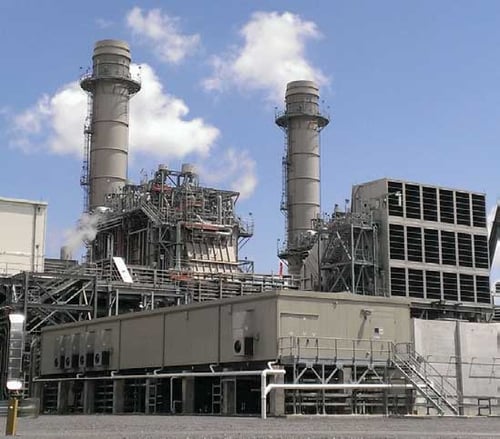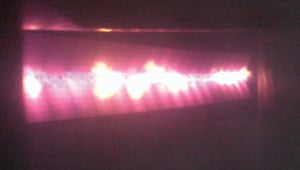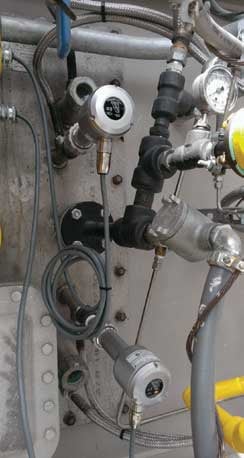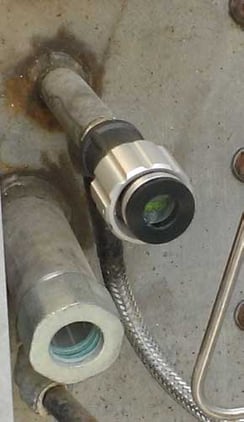クリーナーパワーを国民に
シチュエーション
Entergy Corporationは、メキシコ湾岸地域とアーカンソー州全域で発電所を所有・運営し、3万メガワットの電力を280万人を超える電力会社の顧客に供給しています。同社は、クリーンで効率的な天然ガス焚き複合サイクル発電機によるエネルギー供給を強化することで、クリーンな発電戦略を進めてきました。2012年、エンタジーはルイジアナ州ウェストウェゴにあるニネマイル6号発電所の1号機と2号機、および稼働中の3号機の容量を、最新式のガス複合発電機(CCGT)に置き換えることを検討しました。
 エンタジー・ナインマイル6号機A&B
エンタジー・ナインマイル6号機A&B
チャレンジ
エンタジー社は、CCGT業界のリーダーであるゼネラル・エレクトリック社、ボグト・パワー社、Zeeco とチームを組み、プラントの主要コンポーネントを設計した。これには、直接電力を供給するガスタービン、タービン排ガスから蒸気を発生させ、蒸気タービンを回転させるために使用する熱回収蒸気発生器(HRSG)、そして最後に、HRSGに補助熱を供給し、タービン排ガスからの排出を最小限に抑えるZeecoのダクトバーナーが含まれる。
 18%MCRでローロー発射
18%MCRでローロー発射
2014年末に竣工したが、試運転の際、低負荷時にダクトバーナーが謎の停止をすることがあり、その信頼性が懸念された。何が原因で停止したのか?ダクトバーナーのタービン排気ガス流量分布が原因なのか?ダクトバーナーへの燃料供給は?ダクトバーナーの火炎安定性?低負荷燃焼は25%で行われるはずなのに、最大定格容量の30%以下で停止してしまうのです。
 ProFlame スキャナ
ProFlame スキャナ
解決方法
Zeecoのエンジニアは、エ ンタージー社のニネマイル6発電所が直面している問題、Zeecoのダクトバーナーが低負荷燃焼時に異常停止する問題の解明に取りかかった。彼らはすぐに、Zeecoのダクト・バーナーは設計通りに機能しているが、既存のフレーム・スキャナーが原因で、最悪のケースを想定して適切にチューニングしても、低負荷燃焼時にダクト・バーナーが早期にトリップしてしまうことを突き止めた。Zeeco は、既存のフレーム・スキャナーを、ダクト・バーナーのターンダウン全域で実績のある信頼性の高い火炎検出を行う、独自のProFlame™統合型フレーム・スキャナーに交換した。ProFlame 、他社の火炎スキャナーとの違いは、ProFlame 、最先端の信号処理とスキャナーのチューニングのしやすさにある。ProFlame のディスプレイは、スキャナーの設定が正しいか、調整が必要かを即座にフィードバックします。ZeecoのProFlame スキャナーは、最大定格容量18%の低火力条件下で、信頼性の高い火炎検出を提供した。Zeeco のエンジニアはすぐに、ProFlame スキャナーがターンダウン以上の炎を検出するだけでなく、ダクトバーナーアレイ内の隣接するバーナーエレメントの炎からターゲットバーナーエレメントの炎を安全に識別することを発見した。
 ProFlame スキャナ
ProFlame スキャナ
結果
ZeecoのProFlame 内蔵火炎スキャナーにより、ニネマイル 6 プラントでは、低負荷時の予期せぬ燃焼停止が発生しなくなった。また、ダクトバーナーのターンダウン能力の向上により、燃料の節約も実現した。ProFlame 、各バーナーエレメントに2台のスキャナーを搭載し、炎を安全に検知して、炎があるときにZeeco'のダクトバーナーを確実に作動させる完全冗長モードで、各バーナーエレメントを安全に作動させることができるようになった。信頼性の向上。ターンダウンの向上。安全性の向上。完全な冗長性。ZeecoのProFlame 統合された火炎スキャナーにより、エ ンタージー社のニネマイル6プラントに通電できるようになっただけでなく、ルイジアナ州南東部の電力会社の顧客は、クリーンで効率的な無停電電源の恩恵を確実に受けられるようになった。
ダウンロード